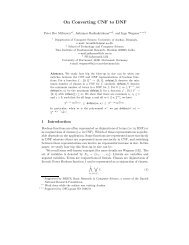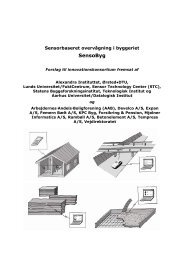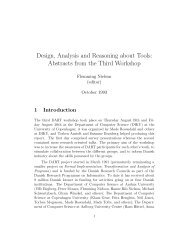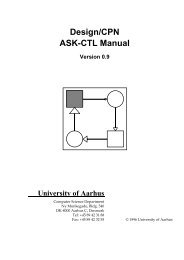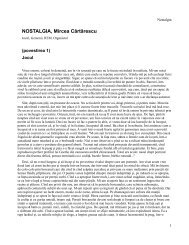towards a provotyping approach in systems development
towards a provotyping approach in systems development
towards a provotyping approach in systems development
Create successful ePaper yourself
Turn your PDF publications into a flip-book with our unique Google optimized e-Paper software.
the new tasks and the old <strong>in</strong>struments; the <strong>in</strong>troduction of new computer<br />
applications can result <strong>in</strong> discrepancies between these and the<br />
old division of labour; <strong>in</strong>tended rules of safety rout<strong>in</strong>es can be <strong>in</strong> opposition<br />
to the need to get th<strong>in</strong>gs done. In NLIS, to a large degree, work<br />
is organized accord<strong>in</strong>g to the <strong>in</strong>spectors’ trades: i.e. health-worker,<br />
craftsman, eng<strong>in</strong>eer, etc. But the objects of their work, workplaces,<br />
display problems <strong>in</strong> all these areas. Hence, the <strong>in</strong>spectors either encounter<br />
problems they lack the competence to solve, or they do not<br />
notice the problems at all.<br />
Discrepancies between actual and prescribed practice. Argyris &<br />
Schön (1978) conceptualize this discrepancy as the difference between<br />
espoused theory and theory-<strong>in</strong>-iuse, see Section 3.1. Engeström perceives<br />
the discrepancy <strong>in</strong> a historical light and calls it a contradiction<br />
between an old and a new activity. In general, every organization formulates<br />
procedures, rules, divisions of labour, etc. for what should be<br />
done, how and why. Often, this differs considerably from what is actually<br />
go<strong>in</strong>g on. An organization may ‘decide’ on a new way of do<strong>in</strong>g<br />
th<strong>in</strong>gs (new company policy, <strong>in</strong>troduction of new computer <strong>systems</strong>,<br />
etc.), but this does not necessarily mean that the decision is <strong>in</strong> fact<br />
effective: that those <strong>in</strong>volved actually act accord<strong>in</strong>g to the new way.<br />
In any practice, one can probably f<strong>in</strong>d many remnants of old practices.<br />
In NLIS, for example, a reorganization was carried out, as a<br />
response to the discrepancy between the organization accord<strong>in</strong>g to the<br />
trades of the <strong>in</strong>spectors and the object of their work. The organization<br />
shifted to a structure based on autonomous groups with the <strong>in</strong>tention<br />
that organizations of a given type should now be treated by a s<strong>in</strong>gle<br />
group. It turned out that many of the <strong>in</strong>spectors (the oldtimers) had a<br />
conception of their role as a ‘lonely cowboy’ (their expression), a remnant<br />
from the old practice counteract<strong>in</strong>g the new group-based practice<br />
(Markussen 1992).<br />
New computer <strong>systems</strong> are <strong>in</strong>evitably confronted by discrepancies <strong>in</strong> the<br />
current practice, usually result<strong>in</strong>g <strong>in</strong> the system not be<strong>in</strong>g used as <strong>in</strong>tended.<br />
An example (Bisgaard et al. 1989a, p. 71): <strong>in</strong> a public office <strong>in</strong> Denmark<br />
the rules held that a certa<strong>in</strong> type of transaction (provid<strong>in</strong>g the customers<br />
with loans) could only be carried out semi-annually; this was implemented<br />
<strong>in</strong> the new account<strong>in</strong>g system. However, a long-last<strong>in</strong>g practice had been to<br />
14








